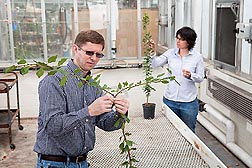Making Peach Trees Fit Better on the Field
When you think of the traits a perfect fruit tree should have, you may think of fragrant blossoms or juicy fruit, but the shape of the tree might not occur to you. In fact, tree shape is very important in agriculture. A tree used for agricultural production—whether for fruit, nuts, or lumber—requires extensive land space, mostly because of its large size and spreading growth habit.
Changing the tree’s shape, either by pruning or through genetics, will affect how that tree fits among other trees in the field and the number of trees that can be grown in an area. Pruning is expensive and labor intensive. A better option is to genetically alter trees to be more compact so they can be planted closer together to increase productivity.
Agricultural Research Service scientists in Kearneysville, West Virginia, along with colleagues at several universities, have identified a gene that controls tree shape in peach trees, specifically the angle at which their branches grow. The work was done using a new gene-mapping method that the team developed.
“To identify the genes responsible for the trait that causes trees to grow in a desirable columnar shape, we devised a strategy we call ‘pnomes’ (pronounced pea-nomes),” says ARS plant molecular biologist Chris Dardick. “The pnomes strategy is based on sequencing the complete set of genes, called the ‘genome,’ of plants that have a trait of interest, like a particular tree shape, and then looking for a common gene or set of genes responsible for that trait.”
Using this technique, the group identified a gene called “PpeTAC1,” which promotes horizontal growth of branches in peach trees. “When this gene is disrupted, the tree branches grow more vertically, producing a pillar or columnar shape to the tree,” says Dardick.
This work was recently published in The Plant Journal and is currently the subject of a 5-year project funded by the USDA National Institute of Food and Agriculture. The researchers filed a patent application on using the gene to manipulate tree architecture.
The team also showed that PpeTAC1 has the same effect in the model plant Arabidopsis thaliana. “Surprisingly, this same gene was found to perform a very similar function in the distantly related rice and corn,” says Dardick. “The knowledge gained from this work should provide technologies for optimizing plant architecture.”
The research team also includes Ann Callahan, Courtney Hollender, Karina Ruiz, and Ralph Scorza, all with ARS’s Appalachian Fruit Research Laboratory; and scientists from the University of Rostock (Germany), and Clemson University.—By Sharon Durham, Agricultural Research Service Information Staff.
This research is part of Plant Genetic Resources, Genomics, and Genetic Improvement, an ARS national program (#301) described at www.nps.ars.usda.gov.
Christopher Dardick is with the USDA-ARS Appalachian Fruit Research Laboratory, 2217 Wiltshire Rd., Kearneysville, WV 25430; (304) 725-3451, ext. 387.
"Making Peach Trees Fit Better on the Field" was published in the November/December 2014 issue of Agricultural Research magazine.







